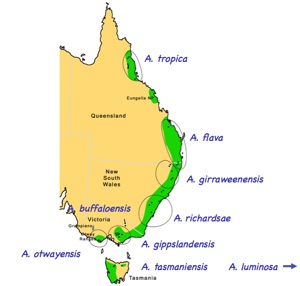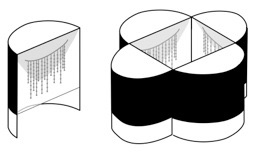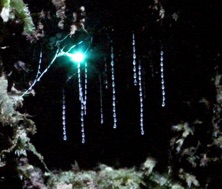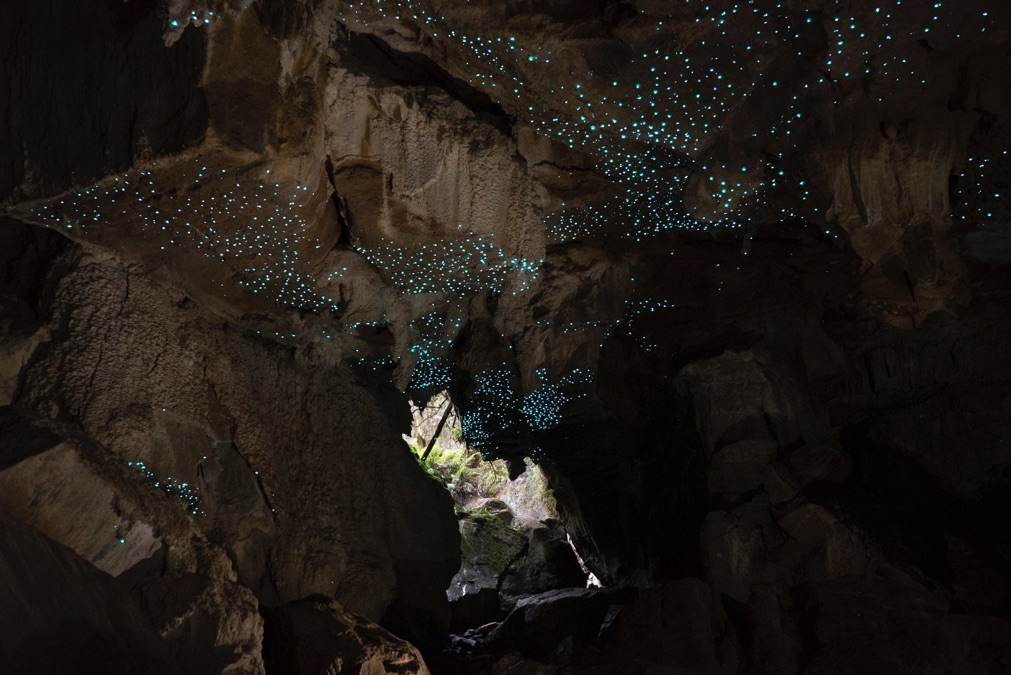Glowworms
What are they?
SCIENTIFIC NAMES:
Arachnocampa tropica
Arachnocampa flava
Arachnocampa girraweenensis
Arachnocampa richardsae
Arachnocampa buffaloensis
Arachnocampa tasmaniensis
Arachnocampa gippslandensis
Arachnocampa otwayensis
Arachnocampa luminosa
Despite the confusion created through their common name, glowworms are the bioluminescent larval stage of a fly (Diptera: Keroplatidae: Arachnocampa spp.). The adults are mosquito-like flying insects. The larvae are the equivalent of the wriggler stage of a mosquito or the maggot stage of a housefly.
Glow-worms are distributed throughout New Zealand and the eastern coast of the Australian mainland as well as Tasmania.
The larvae are a popular attraction in caves or in the forest at night due to their unique display of blue-green bioluminescence. Glow-worms glow to attract their prey, primarily small flies that they capture in a snare of silk and sticky mucus. They are found in wet forests, typically in steep-sided shaded embankments and gullies, or under wet logs. They are also found in wet caves, usually near the entrance.
Why are we studying them?
Glowworms are studied because we need to know more about a commercially valuable insect. At a number of places in Australia and New Zealand tourists flock to caves or rainforest sites to see the impressive displays of bioluminescence.
Glowworms are also of interest because of their unique ecological and physiological adaptations to catching prey: luring them with living light. The precise chemicals they use to produce light are unknown. How they regulate their light intensity and how they modulate and synchronise glowing in caves are of special interest.
Life cycle
The larval stage is long-lasting, from several months to a year in duration. The life cycle of a glow-worm is typical of holometabolous insects (egg, larva, pupa, adult) with the larval stage being the longest. Arachnocampa flava, local to south-east Queensland, has an egg stage lasting 7-9 days; larval stage of 5-12 months; pupal stage lasting 6-7 days and an adult stage lasting only 2-3 days for females and 4-6 days for males.
Food
They feed on prey items that are attracted to their light and trapped in the web. Usually they feed on midges and other night-flying insects.
Species & Relationships
PhD student, Claire Baker identified five new species. They are found along Australia’s eastern and southern coast in rainforest pockets and caves. They are also found in Tasmania. A single species is present in New Zealand; Arachnocampa luminosa.
Glowworm circadian rhythmicity & bioluminescence
Their bioluminescence-producing ability has not been studied in any detail, compared to the fireflies where the light production mechanism and regulation are well-known. We are investigating the factors that affect light production and the intimate links between environment and physiology. Glow-worms are unusual in that they are equally at home in caves and in rainforest habitats so we are investigating the rhythmicity of light output and the factors that entrain the daily rhythms.
Glowworms taken from the rainforest and placed in constant darkness maintain a rhythmic light output over many weeks, indicating that bioluminescence is under the control of an internal clock. Our first experiments were carried out on Arachnocampa flava, which is found only in rainforests; there are no suitable caves in its distribution range. We wanted to find out whether cave larvae show rhythmic glowing: they don’t get cues about the time of day so they might show different patterns of light emission. We have been carrying out regular field excursions to Tasmania to answer this question. The Tasmanian glowworm, Arachnocampa tasmaniensis, has large cave populations. We were surprised to discover that they maintain daily rhythms of glowing in the dark zone of caves, but the phase of the rhythm is almost opposite to that of forest glowworms; the cave populations tend to glow most brightly in the late afternoon, rather than at night (see timelapse video). Deep in the cave, there are no obvious cues telling them the time of day outside the cave, so how do they maintain regular rhythms of glowing? We suspect that they respond to daily cycles in the availability of prey by maximising their light output at the time of day when prey are most likely to be caught.
Not only is the rhythmicity of cave A. tasmaniensis different to A. flava, they also show an ability to synchronise their glows to each other. Larvae within cave colonies are on the same cycle but different colonies can have different cycles. This link shows how we use image analysis of time-lapse photographs to interpret rhythmicity.
Glowworm light production
Glowworms produce light from large cells at the ends of the malpighian tubules. Malpighian tubules usually function as the insect’s kidney but in this unique case, the cells at the tips of the tubules produce light. The rest of the cells carry out the traditional function of urine production. There is no evidence that waste materials are used in producing the light.
The cells that make up the light organ sit underneath the cuticle at the far hind end of the larva. The cuticle is very thin and transparent so the light produced by the cells shines through. The light-producing cells are backed by a reflector made up of masses of trachea: the air-carrying tubes of insects. The reflector is visible as a white mass in the picture above left. The photograph of a glowing light organ (above right) shows the glowing ends of the four tubules.
Light is produced by a reaction between an enzyme (luciferase) and a substrate (luciferin), related to the chemicals that produce light in fireflies. The molecule, ATP, provides energy for the reaction.
Reaction to disturbance
Some tour operators report that glow-worms react to sound disturbance by dimming their lights. Others report that sound causes the glow-worms to brighten. At Waitomo Caves in New Zealand, tourists are asked to remain quiet as they view the glow-worms so that they do not disturb them and affect the display. In other places, waterfalls produce noise and the glowworms do not appear to be affected.
Honours student, Julie-Anne Popple showed that glow-worms are much more sensitive to vibration than to air-borne sound. They respond to medium-intensity signals by rapidly increasing their light output and then gradually return to the baseline level. They are most sensitive to vibrations around 100 Hz; about the same as the wing-beat frequency of a small, flying insect. The light response may be an adaptation that increases the chances of attracting prey when detected in the vicinity. Alternatively, it might simply be a startle response.
Reaction to artificial light
Glow-worms are sensitive to artificial light when they are glowing. Exposure to bright light will cause them to douse their own lights. Light output from individual glowworms tends to fluctuate through the night due to their movements within the snare and activity such as maintaining their silk lines. In laboratory experiments, honours student Rebecca Morley showed that glow-worms switch on about 30 minutes after onset of darkness and rapidly reach maximum brightness. They gradually decrease in brightness toward dawn.They respond to artificial light by switching off their own light. Recovery time to full light output depends on:
• the duration of exposure
• the intensity of exposure
• the time of night.
Glow-worms are not equally sensitive to all colours. It appears that they have ultraviolet, blue and green photoreceptors. Although many insects are completely insensitive to red, glow-worms can see red light and switch off in response but the response is far less than when they are exposed to blue, green yellow or ultraviolet.
More Links
Follow these links for more information;


To prove that synchronisation occurs, larvae were placed in individual containers, preset to different bioluminescence rhythms and then exposed to each other in constant darkness. After a few days they synchronised their rhythms so all were brightening and dimming on the same cycle.
KEY POINTS
Glow-worms can control their light output intensity
Light output varies through the night in a regular pattern
Light intensity increases rapidly when larvae feel vibration in their snares
Light output is switched off when larvae are exposed to light above a threshold intensity
Light output comes under circadian regulation
Ambient light inhibits glowing and resets the rhythm in forest glow-worms
Cave glow-worms also show rhythmic light output
Cave glowworms synchronise their bioluminescence by detecting and matching each others’ glow cycles
We suspect that the time of prey flight in the cave entrains cave glowworms’ rhythms



